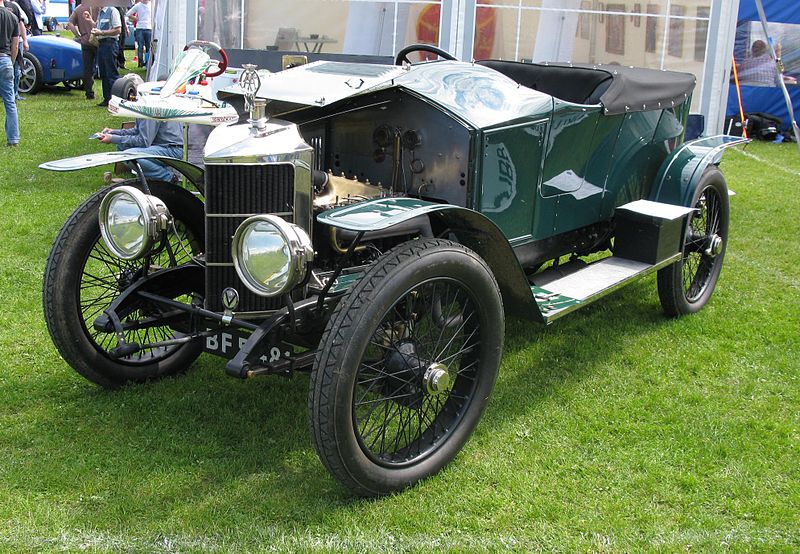 According to historian Richard Hough, "Any history of the sports car must begin with the 60 hp Mércèdes of 1903. In the 60 hp model, described at the time as a fast touring car, Wilhelm Maybach and Paul Daimler combined in remarkably successful form a number of features which were to be slavishly imitated, first in Europe and later in America, for almost forty years. These included a pressed-steel chassis, a 4-speed gate change, honeycomb radiator, push-rod-operated overhead inlet valves, low-tension magneto ignition and a remarkably successful suspension arrangement. They were integrated with success to provide a safe and well-balanced machine with a higher performance than any other contemporary production car. The 60 hp Mércèdes looked right from the start and caused a great impression wherever it appeared." When the specially built 90 hp racing car for the 1903 Gordon Bennett race was destroyed in a fire, a production 60 hp was famously substituted and driven to victory by Belgian Camille Jenatzy.
According to historian Richard Hough, "Any history of the sports car must begin with the 60 hp Mércèdes of 1903. In the 60 hp model, described at the time as a fast touring car, Wilhelm Maybach and Paul Daimler combined in remarkably successful form a number of features which were to be slavishly imitated, first in Europe and later in America, for almost forty years. These included a pressed-steel chassis, a 4-speed gate change, honeycomb radiator, push-rod-operated overhead inlet valves, low-tension magneto ignition and a remarkably successful suspension arrangement. They were integrated with success to provide a safe and well-balanced machine with a higher performance than any other contemporary production car. The 60 hp Mércèdes looked right from the start and caused a great impression wherever it appeared." When the specially built 90 hp racing car for the 1903 Gordon Bennett race was destroyed in a fire, a production 60 hp was famously substituted and driven to victory by Belgian Camille Jenatzy. With a speed limit of 20 mph imposed on public roads in England, there was little incentive for the manufacture of fast production cars there until the advent of the Brooklands track in 1907. Brooklands helped to create a market among enthusiasts in Britain for high-efficiency production cars such as Sunbeam (notably the 12/16 designed by Louis Coatalen), Star, Talbot, Crossley and Straker-Squire.
With a speed limit of 20 mph imposed on public roads in England, there was little incentive for the manufacture of fast production cars there until the advent of the Brooklands track in 1907. Brooklands helped to create a market among enthusiasts in Britain for high-efficiency production cars such as Sunbeam (notably the 12/16 designed by Louis Coatalen), Star, Talbot, Crossley and Straker-Squire.
Though the term sports car would not be coined until after World War One, the first sports cars are considered to be the 3 litre 1910 Prince
.jpg/1024px-1903_Mercedes_60HP_(20758376105).jpg) Henry (Prinz Heinrich) Vauxhall 20 hp (tax rating), and the 27/80PS Austro-Daimler designed by Ferdinand Porsche. Porsche's active engineering career spanned the history of the sports car over the first half of the twentieth century, first coming to prominence at thirty-five years of age as chief designer and technical director for the 1910 Prince Henry Austro-Daimler (then Austrian-Daimler). The Prince Henry Vauxhall was designed by L.H. Pomeroy and featured a 3-liter engine that gave 60 hp at 2800 rpm, very high performance for the period with impressive reliability, and very modern (at the time) "torpedo" flush-bonnet coachwork. The Prince Henry Vauxhalls were important to the growing popularity of fast motor cars in Britain. Like the 60 hp Mercedes the Prince Henry Austro-Daimler and Vauxhall were production fast touring cars. The Prince Henry Tours (which were similar to modern car rallies) were among the most famous sporting events of the period, bringing great prestige to successful entrants. Porsche himself drove the Austro-Daimler to victory in the 1910 Prince Henry Tour. The Prince Henry Tours started the evolution of reasonably large and technically advanced production sports cars.
Henry (Prinz Heinrich) Vauxhall 20 hp (tax rating), and the 27/80PS Austro-Daimler designed by Ferdinand Porsche. Porsche's active engineering career spanned the history of the sports car over the first half of the twentieth century, first coming to prominence at thirty-five years of age as chief designer and technical director for the 1910 Prince Henry Austro-Daimler (then Austrian-Daimler). The Prince Henry Vauxhall was designed by L.H. Pomeroy and featured a 3-liter engine that gave 60 hp at 2800 rpm, very high performance for the period with impressive reliability, and very modern (at the time) "torpedo" flush-bonnet coachwork. The Prince Henry Vauxhalls were important to the growing popularity of fast motor cars in Britain. Like the 60 hp Mercedes the Prince Henry Austro-Daimler and Vauxhall were production fast touring cars. The Prince Henry Tours (which were similar to modern car rallies) were among the most famous sporting events of the period, bringing great prestige to successful entrants. Porsche himself drove the Austro-Daimler to victory in the 1910 Prince Henry Tour. The Prince Henry Tours started the evolution of reasonably large and technically advanced production sports cars.
Hispano-Suiza's Alfonso XIII is also considered one of the earliest sports cars, developed between 1911 and 1914 from the successful Coupe de l'Auto voiturette-race winning Hispano, designed by talented Swiss engineer Marc Birkigt and originally known as the Type 15T or 15/45hp depending on the market. The model was renamed for Spain's King Alfonso XIII, Birkigt’s patron and an enthusiast for the marque, and around 500 were produced, impressive for the time. Another product of the French voiturette (or small car, up to 3-liter) races from 1906 to 1910, was the tiny and fast Bugatti Type 13 which found a small clientele before the Great War and gained full prominence in the immediate post-war period.


.jpg/1024px-Mus%C3%A9e_de_l'automobile_-_Mulhouse_-_Hispano_Suiza_-_BH5A5820_(16646659582).jpg)
.jpg/800px-1912_Stutz_Bearcat_Speedster_front_quarter_(7704047066).jpg)
.jpg/800px-1913_Mercer_Series_J%2C_Type_35_Raceabout_(1418364979).jpg)







.jfif)


No comments:
Post a Comment